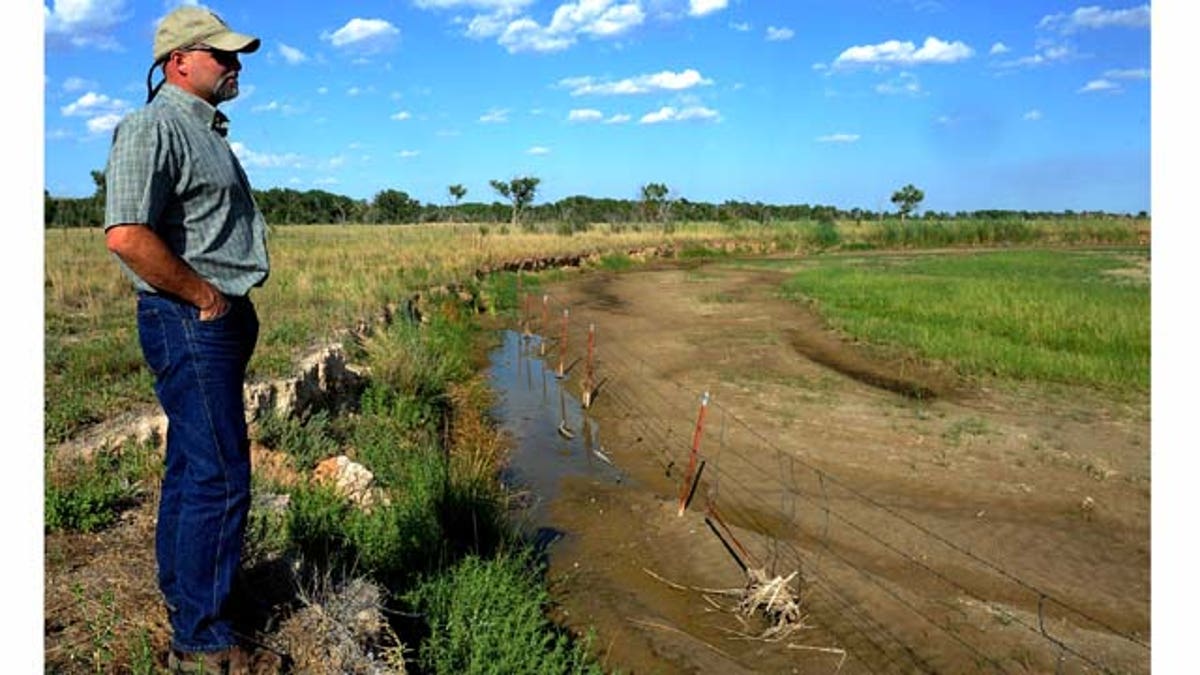
Aug. 2, 2011: Jeff Bonner, Wildlife Biologist with Texas Parks and Wildlife Department, looks over the banks of the almost completely dried up Canadian River, in Hemphill County in Amarillo, Texas. With the second-worst drought in Lone Star State history expected to stick around for at least a year, biologists say the impacts on those habitats will be so severe and widespread they will last for years after the drought ends. (AP Photo/Michael Norris, file) (AP2011)
The severe drought in Texas, which has dried up the state's ecosystem and threatened the survival of rare wildlife, has forced federal officials to ready plans to begin an evacuation of some of the state's endangered species.
Months with almost no rain have caused water levels to drop by half or more in many rivers, lakes and other bodies of water, including springs in the central Texas Hill Country that are the only remaining habitat for populations of small fish, amphibians and other creatures.
If the water continues to drop sharply, U.S. Fish and Wildlife Service officials are preparing to net up large samples from the springs to take to a hatchery for preservation.
Such evacuations have been rare in the past, with one ordered in 2000 to rescue several species of mussels in Georgia. But such emergency measures could become more frequent if the drought here continues for months or years, as many forecasters predict. Texas is home to 86 endangered and threatened species.
"We're definitely concerned," Fish and Wildlife Service biologist Tom Brandt said. "I think we have moved to another step in making sure everything is ready. We're in a planning stage right now." The evacuations would begin if water levels in two declining springs drop by more than another 50 percent, after similar reductions in recent months.
- We Salute These Hispanic Trailblazers
- Nelson Cruz, Josh Hamilton Hit Home Runs in Return to Texas Rangers Lineup
- Texas Latino Senators Brace for Immigration Bill Debate
- How to Save Money on Coffee
- Mexico’s Drug War Has U.S. Businesses Reluctant to Open Up Shop
- Illegal Immigration Pipeline From South Asia to US Passes through Guatemala
- Jobless Mexicana Flight Attendants Pose for Calendar
Only 9.6 inches of rain has fallen on average across Texas this year, a little more than half the normal amount. Fish are dying in lakes and rivers from lack of water and low oxygen levels. Growth of vegetation for animal habitat is down dramatically.
"Texas flora and fauna are adapted to the harsh, extreme conditions. However, this particular drought is testing the limits of native populations," said Cindy Loeffler, a water resource expert with Texas Parks and Wildlife Department.
The lack of rainfall is intensifying competition for scarce water among wildlife, agriculture and local users. In this case, the Edwards Aquifer, which feeds the two springs that contain the vulnerable species, also provides water to almost two million people as well as for irrigation. The state has imposed new pumping restrictions on some water users and suspended the water rights of others. Federal law bars harming threatened species.
The Comal and San Marcos springs are the largest in Texas. The San Marcos Springs are on the bottom of a 16-acre lake, percolating water up through fissures in the limestone lake bottom. Comal Springs is in a secluded area of oak and cedar trees in a park in New Braunfels.
The springs contain the only remaining populations of two small fish, the fountain darter and the San Marcos gambusia; the Texas blind salamander; the San Marcos salamander; the Comal Springs Riffle beetle, the Comal Springs Dryopid beetle, the Peck's cave amphipod, an invertebrate; and Texas wild-rice. In fact, the San Marcos gambusia hasn't been seen since the early 1980s and could already be extinct.
This week (Aug. 22), the spring flow at Comal Springs was measured at 165 cubic feet per second, down from its average of 300. The flow at San Marcos Springs was 93, down from an average of 180. If the flows begin to approach 50 in Comal Springs and 75 in San Marcos Springs, wildlife agents and volunteers would collect large samples of the wildlife to add to small captive populations in tanks at the hatchery near San Marcos, which is about 30 miles from Austin.
Brandt said he couldn't project when the springs might approach the danger point, and hopes the water conservation efforts keep the springs viable until rains come. San Marcos Springs has never gone dry but Comal Springs went dry from June to November 1956, near the end of a seven-year drought that was the worst in Texas history. The current drought, which began last fall, is already the second worst.
Keeping the species alive is important, said Brandt. "They are a barometer," Brandt said. "We want to keep the habitat in as good a condition as we can and the endangered species, the health of those populations, tells us how well we're doing that."
If the drought continues unabated, "Then we're all in serious trouble and more severe steps will need to be taken," said Ken Kramer of the Lone Star Chapter of the Sierra Club, which has gone to federal court in the past to protect wildlife in the state.
The Edwards Aquifer Authority, which manages pumpers of the water sourcey, has been directed by the Legislature to come up with conservation options for the future.
So far, lakes, streams and other waters in the north and western parts of Texas are drying up the fastest, and the plants and animals that rely on them are being watched the most closely. "We are internally at parks and wildlife having discussions, 'what other species out there might need help?' " said Loeffler
Based on reporting by The Associated Press.
Follow us on twitter.com/foxnewslatino
Like us at facebook.com/foxnewslatino
